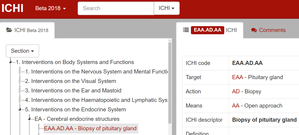The International Classification of Health Interventions (ICHI) is a system of classifying procedure codes being developed by the World Health Organization (WHO). It is currently available as a beta 3 release. The components for clinical documentation are stable. The component on public health interventions is in the process of being finalized.[1][2] Updates on development and status of the classification are listed on WHO home page.[3]
YouTube Encyclopedic
-
1/3Views:15 0981 2881 445
-
Video 1 SA: What is the International Classification of Functioning, Disability and Health (ICF)?
-
WHAT IS ICD-10-AM? | Medical Coding Around the World
-
Classification of healthcare workers - Video Lesson for Nursing Students
Transcription
History
The WHO began development of ICHI in 2012 as a replacement for International Classification of Procedures in Medicine (ICPM), which was a system of classifying procedure codes published from 1978. ICPM, however, never received the same international acceptance as ICD-9. Due to difficulties in the consultation processes, development of the ICPM effectively stopped in 1989.[4] As a result, nations would go on to develop their own individual classifications for procedures and interventions incompatible with the ICPM approach. Germany's OPS-301 is based on the Dutch extension of ICPM; the ICPM-DE.[5]
The ICHI's framework is designed to allow international comparison of data from the known national interventions classifications, and as a system for clinical documentation of individual interventions.
Identifiers
ICHI is using letters to identify a procedure. For example, code EAA.AD.AA is for Biopsy of Pituitary gland. A decimal number following a 3rd decimal point will serve to identify individual interventions and methods within one category.

Relationship to SNOMED CT (procedures hierarchy)
ICHI is not linked to SNOMED. In contrast to SNOMED, ICHI covers interventions of all domains in health at the individual and population level. Some procedural concepts that are present in SNOMED CT do not have a corresponding concept in ICHI (e.g., endoscopy).[6][7] SNOMED CT is using attributes that may link procedures to other related concepts. For example, SNOMED CT concept model for procedure allows linking substances to procedures using 'Direct Substance' attribute. Similarly, the ICHI allows postcoordination with devices or substances. As a result, the scope for the set of relationships in ICHI is broader than in SNOMED CT, due to the common foundation with ICD-11.
Development
The first test approach to ICHI was largely derived from the Australian Classification of Health Interventions (ACHI),[8] a portion of the Australian standard ICD-10-AM, which in turn was largely derived from ICD-10 and the United States extension ICD-9-CM. However, that approach was later dropped.
For accounting, the Australian health administration generated a code of Diagnosis-related groups which in effect again deviates from the WHO basis. The same phenomenon applies to DRG codes in Germany and other countries. Other codes generated by the UN accredited International Standards Organisation ISO defined a deviating scope.[9] Cooperation of ISO and WHO is not detected.
See also
- ICD-10-PCS (US-American version for coding)
- Clinical coding
- Diagnosis codes
- Medical classification
References
- ^ "International Classification of Functioning, Disability and Health (ICF)". ICHI.
- ^ "International Classification of Health Interventions (ICHI)".
- ^ "International Classification of Health Interventions (ICHI)".
- ^ "International Classification of Health Interventions (ICHI)". World Health Organization - Classifications. Retrieved 26 April 2015.
- ^ "DIMDI - OPS - German Procedure Classification". www.dimdi.de. Retrieved 9 December 2016.
- ^ Thun, S.; Dewenter, H. (2018). "ICD-11, ICHI and SNOMED CT-What do the standards mean for eHealth applications?". Bundesgesundheitsblatt - Gesundheitsforschung - Gesundheitsschutz. 61 (7): 812–820. doi:10.1007/s00103-018-2759-2. PMID 29846742. S2CID 44176523.
- ^ Rodrigues, JM; Kim, S; Trombert Paviot, B; Lee, JJ; Aljunid, S (2017). "How to Link SNOMED CT Procedure and WHO International Classification of Health Interventions (ICHI)". Studies in Health Technology and Informatics. 236: 40–47. PMID 28508777.
- ^ "International Classification of Health Interventions" (PDF). University of Sydney. 2012. Archived from the original (PDF) on 2014-11-29.
- ^ ISO 9999:2011. Assistive products for persons with disability -- Classification and terminology
External links
- WHO site
- Australian site (Australian version for coding)
